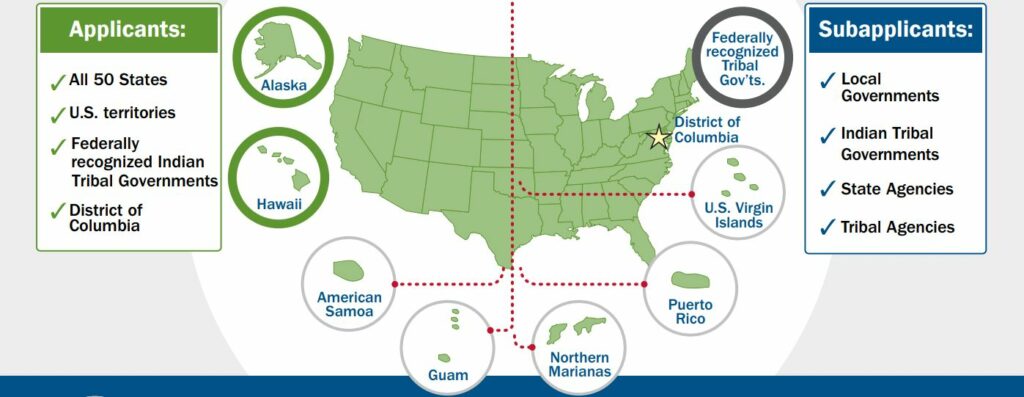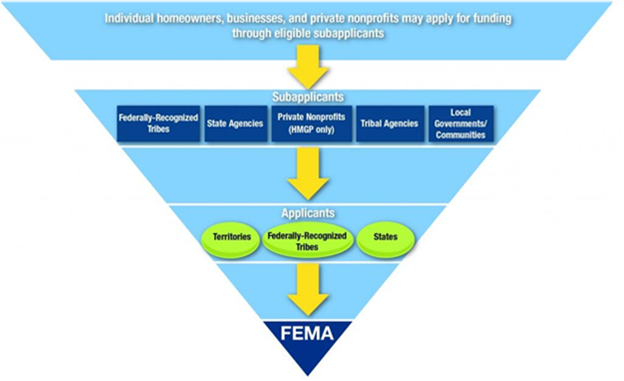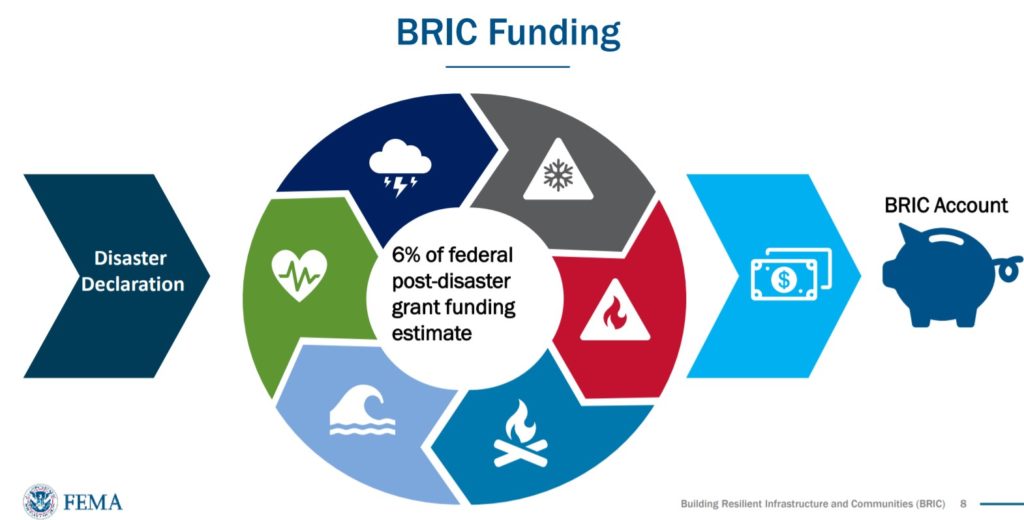
Grant opportunity that provides funding to coastal hazard mitigation construction projects.
FEMA’s Building Resilient Infrastructure and Communities Program
FEMA has announced their Hazard Mitigation Assistance programs for Federal Fiscal Year 2020 (webpage here). These FEMA programs are some of the few grant opportunities that provides major funding to coastal hazard mitigation construction projects. In this slate of funding opportunities is the new Building Resilient Infrastructure and Communities program, or BRIC. We have heard that BRIC is coming for a while now, so what is it all about?
IMMEDIATE ACTION: For Wisconsin communities interested in applying for BRIC funding, a notice of intent to apply must be sent to Wisconsin Emergency Management (WEM) by deadline of September 29, 2020. To notify WEM, email DMAWEMHazardMitigation@wi.gov with the name of the community, contact information, and a brief description of the project.
What is BRIC?
BRIC is a new FEMA pre-disaster hazard mitigation program that replaces the existing Pre-Disaster Mitigation (PDM) program. BRIC stands for Building Resilient Infrastructure and Communities. This program “works to support capability- and capacity-building activities, encourage and enable innovation, promote partnerships, and enable high-impact investments to reduce risk from natural hazards, with a focus on infrastructure, safety, and health at the community level.” In essence, it provides funding for pre-disaster mitigation activities.
Who is eligible for funding in Wisconsin?
In Wisconsin, Wisconsin Emergency Management (WEM) serves as the official Applicant to FEMA to submit subapplications for the following eligible subapplicants:
- The state and state agencies
- Federally-recognized tribal governments that have participated in the planning process for and adopted a local or standalone Tribal mitigation plan
- Local units of government (towns, villages, cities, counties) that have participated in the planning process for and adopted a local mitigation plan
Individuals, businesses, and private non-profits are NOT eligible to apply for grants but may be sponsored by an eligible local unit of government.

The process individual homeowners, businesses, subapplicants, and applicants must go through in order to apply for FMA grants and how this process leads to FEMA. This image shows the general application hierarchy for FEMA, however, it varies by state to state. Image credit: Ct.gov
How does funding work for this program?
BRIC is funded by a 6% set-aside from federal post-disaster grant funding in a given year, which for the 2020 competition amounts to $500 million. Some of this money is allocated to state and tribal governments while the remainder is left for a national competition. In 2020, about $33.6 million is set aside for state government agencies and $20 million for tribal governments. Wisconsin has been allocated $600,000 from this state set-aside funding, from which Wisconsin Emergency Management (WEM) hopes to provide a significant amount of funding for countywide hazard mitigation plans. This leaves a balance of $446.4 million left for a National Competition in which any eligible applicant can request funds through the BRIC grant process. The National Competition has award limits of $50 million per subapplicant.

Image of how funding works in the BRIC program. Photo credit: American shore & beach preservation association
Activities Eligible for BRIC Funding:
The $446.4 national BRIC competition has three categories of eligible activities:
- Capability- and Capacity-Building (C&CB): This type of grant is for projects that will reduce the risk and damage from future natural hazards, increase resilience in the area and enhance a community’s ability to be prepared. Activities covered by this grant include those which increase “the knowledge, skills, expertise, etc.” of a subapplicant. They may consist of “building codes activities, partnerships, project scoping, mitigation planning and planning -related activities” as well as others (FEMA).
- Mitigation Projects: FEMA defines this as “cost-effective projects designed to increase resilience and public safety; reduce injuries and loss of life and reduce damage and destruction to property, critical services, facilities, and infrastructure”. These projects must align with an approved and adopted hazard mitigation plan and conform to the most up-to-date standards, and be in accordance with FEMA’s Cost-Benefit Analysis toolkit (version 6.0), among other criteria.
- Management Costs: Subapplicants can choose to request the BRIC grant to help cover management costs. This involves including an additional 5% of their overall grant award. Management Costs may involve financial assistance or administrative expenses involved.
To get an idea of the array of eligible mitigation activities, FEMA has put together a Mitigation Action Portfolio of case study examples. You can access it here: https://www.fema.gov/sites/default/files/2020-08/fema_mitigation-action-portfolio-support-document_08-01-2020_0.pdf
How To Apply for BRIC Funds
In Wisconsin, Wisconsin Emergency Management (WEM) serves as the Applicant to FEMA as well as the pass-through entity for the subapplications. Interested subapplicants will work with WEM to prepare a subapplication for funding, which WEM will ultimately submit an application to FEMA.
To begin this application process, subapplicants must notify WEM of their intent to apply by September 29, 2020 with an email to DMAWEMHazardMitigation@wi.gov with the name of the community, contact information, and a brief description of the project. Prospective subapplicants may also contact WEM at that address for more complete application instructions as well as eligibility and feasibility questions.
BRIC Webinar for Wisconsin and Minnesota Coastal Communities
Wednesday, September 16, 1 – 3 pm Central Time
Register to attend: https://uwextension.zoom.us/meeting/register/tJAof–vrjsrHtbopBpfP5svEMKt1KJOHhnU
In this webinar, three Great Lakes region hazard mitigation and emergency management specialists will share information about the BRIC program including how BRIC can support coastal resiliency. Presenters will also share coastal project examples from the Great Lakes region. Following their presentations, the speakers will be available for a panel Q&A. If you are interested in learning more about the BRIC program, this is an opportunity to have your questions answered by regional experts. Register to join us on September 16. Note that this webinar is organized by a Coastal Hazards of Superior (CHAOS) group focused on Minnesota and Wisconsin’s Lake Superior coasts but the content will be applicable to Wisconsin’s Lake Michigan coast as well.
Speakers for this webinar are:
Jen Nelson, State Hazard Mitigation Officer, State of Minnesota, Homeland Security and Emergency Management, Department of Public Safety
Robyn Fennig, State Hazard Mitigation Officer, Wisconsin Emergency Management, Department of Military Affairs
Morgan Holloway, Hazard Mitigation Senior Program Specialist, Federal Emergency Management Agency
For More Information on BRIC:
Find more information on the BRIC program at these links:
Full BRIC Notice of Funding Opportunity description
2020 funding opportunities for hazard mitigation assistant grants
September 10, 2020 | By Kayla Wandsnider, Coastal Resilience Project Assistant, Wisconsin Sea Grant




